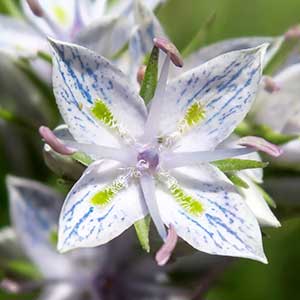Frasera speciosa
Frasera albicaulis
deer's-ears, elkweed, frasera, giant frasera, monument plant
white-stem elkweed, white-stem frasera
1.
1–few, with several rosettes.
blades not white-margined;
basal spatulate or oblanceolate to elliptic-obovate, 7–50 × 1–15 cm, apex rounded to acute;
cauline leaves whorled, blade oblong-lanceolate.
blades narrowly white-margined;
basal oblanceolate, 4–23 × 0.3–1.2(–2) cm, basal leaves generally longer than lowest internode;
cauline leaves opposite, proximal blades oblanceolate to oblong, distal linear-oblong.
elongate, open proximally, ± dense distally.
narrow, 1.5–4(–5) cm wide, interrupted proximally, ± continuous distally.
calyx 10–25 mm;
corolla pale yellowish green, purple-dotted, occasionally suffused with purple distally, 12–25 mm, lobes elliptic-oblong to obovate, apex [obtuse or] acute to short-acuminate;
androecial corona scales 7–9 mm, deeply multicleft;
style slender, distinct;
nectaries and foveae 2 per corolla lobe, foveae narrowly elliptic, opening directly adaxial to nectary, each opening with a ± even fringe all around, the pair opening into a green but not rimmed area on the corolla surface.
calyx 3–7(–12) mm;
corolla greenish white to pale or medium blue, usually dark blue- to purple-dotted and/or with a dark blue, purple, or green central stripe (except in var. idahoensis), 6–12 mm, lobes oblong-obovate-elliptic, widest near midlength, abruptly tapering to acute to short-acuminate apex;
androecial corona scales present, variable among the varieties;
style slender, distinct;
nectaries and foveae 1 per corolla lobe, foveae distal to nectary, opening into an elliptic-oblong to lance-ovate differentiated area on the corolla surface, rim fringed all around but with fringes shorter distally, or not fringed toward distal end.
= 78.
Frasera speciosa
Frasera albicaulis
Swertia radiata var. maderensis Henrickson, endemic to Mexico, is conspecific with Frasera speciosa, but the necessary combination in Frasera has not been published. If that is done, our material will become var. speciosa.
(Discussion copyrighted by Flora of North America; reprinted with permission.)
Varieties 5 (5 in the flora).
Frasera albicaulis varies in vegetative and abaxial corolla puberulence and in the size and dissection of the androecial corona. It has sometimes been divided into several species and additional varieties, but, from the material available for study at the time of this writing, it appears appropriate to recognize only five varieties, although F. ackermaniae might be considered for inclusion at varietal rank. Each of these varieties has a more or less distinct geographic range, but some intergrade.
(Discussion copyrighted by Flora of North America; reprinted with permission.)
1. Stems and abaxial or both leaf surfaces puberulent; rim of differentiated area on corolla surface not fringed at distal end. | → 2 |
2. Corona scales oblong, margins lacerate or deeply toothed, ultimate divisions threadlike. | var. albicaulis |
2. Corona scales ovate to obovate or oblanceolate, margins entire or shallowly 2–3-lobed, rarely absent. | var. modocensis |
1. Stems glabrous; leaf blades glabrous or puberulent only near base and abaxially along midvein; rim of differentiated area on corolla surface fringed all around, fringes shorter near distal end. | → 3 |
3. Corona scales ovate to elliptic, margins entire or shallowly undulate-erose or toothed. | var. cusickii |
3. Corona scales ovate to elliptic to oblong-lanceolate, margins lacerate or deeply lobed. | → 4 |
4. Corollas greenish white or pale to medium blue, generally with dark blue to purple spots; corona scales 1–4 mm, oblong-lanceolate. | var. nitida |
4. Corollas pale blue, usually without darker spots; corona scales 2–6 mm, widely ovate to elliptic. | var. idahoensis |


